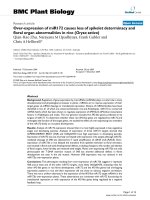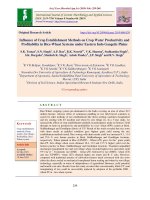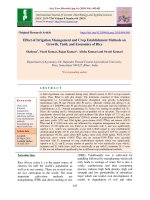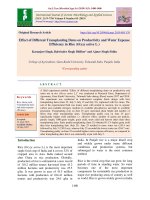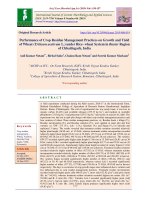Influence of crop establishment methods, weed and nutrient management practices on growth and yield of direct seeded rice (Oryza sativa) - Trường Đại học Công nghiệp Thực phẩm Tp. Hồ Chí Minh
Bạn đang xem bản rút gọn của tài liệu. Xem và tải ngay bản đầy đủ của tài liệu tại đây (163.84 KB, 7 trang )
<span class='text_page_counter'>(1)</span><div class='page_container' data-page=1>
<i><b>Int.J.Curr.Microbiol.App.Sci </b></i><b>(2017)</b><i><b> 6</b></i><b>(11): 3725-3737 </b>
3725
<b>Original Research Article </b>
<b>Influence of Crop Establishment Methods, Weed and Nutrient Management </b>
<b>Practices on Growth and Yield of Direct Seeded Rice (</b>
<i><b>Oryza sativa</b></i>
<b>) </b>
<b>V. Sridevi1*, S. Jeyaraman2, S. Ramasamy2 and C. Chinnusamy2</b>
1
Pandit Jawaharlal Nehru College of Agriculture and Research Institute,
Pondicherry University, Karaikal, Puducherry U.T. - 609 603, India
2
Tamil Nadu Agricultural University, Coimbatore, Tamil Nadu-641 003, India
<i>*Corresponding author </i>
<i><b> </b></i> <i><b> </b></i><b>A B S T R A C T </b>
<i><b> </b></i>
<b>Introduction </b>
Direct seeding on puddled soil either through
broadcasting or row seeding by drum seeder
is gaining popularity due to low labour
requirement, shorter crop duration, efficient
water use and provide comparable grain yield
as that of transplanted rice (Gangwar <i>et al.,</i>
2008). However, it has many limitations such
as uneven crop stand, difficulty in thinning
and gap filling and inefficient manual
weeding. These problems can be overcome by
the Direct Planting System (DPS), in which
desired plant density (25 cm x 25 cm) like
SRI is maintained by thinning the direct
seeded rice with manual and mechanical
means (rotary weeder). There was 60 per cent
saving of labour during crop establishment
stages (sowing, transplanting and weeding) as
compared to transplanted rice (Ramasamy <i>et </i>
<i>International Journal of Current Microbiology and Applied Sciences </i>
<i><b>ISSN: 2319-7706</b></i><b> Volume 6 Number 11 (2017) pp. 3725-3737 </b>
Journal homepage:
Field experiments were conducted in clay loam soil of Tamil Nadu Agricultural
University, Coimbatore during <i>rabi</i>, 2009-10 and 2010-11 to identify the suitable crop
establishment methods, weed and nutrient management practices in direct seeded rice. The
field experiments were laid out in split plot design replicated thrice. Crop establishment
methods and weed management practices (M1: Direct planting system (DPS), M2: DPS +
EPOE of almix @ 4 g a.i. ha-1, M3: DPS without thinning and hand weeding in the
intersect + EPOE of almix @ 4 g a.i ha-1, M4: drum seeding) were assigned to main plots
and nutrient management practices (S1: Absolute control, S2: Recommended fertilizer dose
of 150:50:50 kg NPK ha-1 + 12.5 t FYM ha-1, S3: S2 + <i>Pseudomonas</i> <i>fluorescens</i> (Seed
treatment @ 10 g kg-1 and soil application @ 2.5 kg ha-1 and 0.2 per cent foliar spray), S4:
S2 + <i>Azophosmet</i> (Seed treatment @ 2 g kg-1 and soil application @ 2 kg ha-1) + 0.1 per
cent Pink pigmented facultative methylotroph (PPFM) foliar spray) were allocated to sub
plots. The results showed that the highest growth, yield attributes, grain yield and harvest
index were obtained by direct planting system (DPS) + EPOE of almix at 4 g a.i. ha-1. The
drum seeding produced the highest straw yield. The combined application of
recommended dose of fertilizer (150:50:50 kg NPK ha-1) along with 12.5 t ha-1 FYM and
biofertilizers <i>viz., Azophosmet</i> as soil and seed treatment and 0.1 per cent pink pigmented
facultative methylotroph (PPFM) as foliar spray at active tillering, panicle initiation and 50
per cent flowering stage registered higher growth, yield attributes, grain and straw yield
and harvest index.
<b>K e y w o r d s </b>
Direct seeded rice,
Growth attributes,
Harvest index, Yield
attributes, Yield.
<i><b>Accepted: </b></i>
26 September 2017
<i><b>Available Online:</b></i>
10 November 2017
</div>
<span class='text_page_counter'>(2)</span><div class='page_container' data-page=2>
<i><b>Int.J.Curr.Microbiol.App.Sci </b></i><b>(2017)</b><i><b> 6</b></i><b>(11): 3725-3737 </b>
3726
<i>al.,</i> 2006). A weed-free period for the first
30-45 days after sowing (DAS) is required to
avoid any loss in grain yield (Singh and
Singh, 2010). Herbicides alone or in
combination with mechanical and hand
weeding are effective in controlling weeds in
rice (Mirza <i>et al.,</i> 2009). Soil fertility
maintenance is essential for sustainable rice
production. Due to escalation of fertilizer
prices and associated environment problem of
inorganic cultivation, it is necessitated to
exploit the available resources of nutrients
under the theme of integrated nutrient
management. Under this approach, the best
available option lies in the complimentary use
of biofertilizers, organic manures in suitable
combination of inorganic fertilizer
(Jayasankar and Thyagarajan, 2010). With
this background, the experiments were carried
out to elucidate the growth, yield attributes
and productivity of direct seeded rice under
different crop establishment methods, weed
and nutrient management practices.
<b>Materials and Methods </b>
The field experiments were conducted to
evaluate the effect of crop establishment
methods, weed and nutrient management
practices on the growth, yield attributes and
yield of lowland direct seeded rice during
<i>rabi</i>, 2009-10 and 2010-11 at the wetlands of
Tamil Nadu Agricultural University,
Coimbatore which is situated in North
western agro-climatic zone of Tamil Nadu at
11N and 77E with an altitude of 426.7 m
above mean sea level.
Soil of the experimental fields was clay loam
in texture classified taxonomically as <i>Vertic </i>
<i>Ustochrept</i>, low in available nitrogen
(197.3-214.2 kg ha-1), medium in available
phosphorus (11.8-12.5 kg ha-1) and high in
available potassium (451.8-509.0 kg ha-1).
The medium duration rice variety ‘CO (R) 50’
was used as test variety.
The field experiments were laid out in split
plot design replicated thrice. Crop
establishment methods and weed management
practices (M1: Direct planting system (DPS),
M2: DPS + EPOE of almix @ 4 g a.i. ha-1,
M3: DPS without thinning and hand weeding
in the intersect + EPOE of almix @ 4 g a.i ha
-1
, M4: drum seeding) were assigned to main
plots and nutrient management practices (S1:
Absolute control, S2: Recommended dose of
150:50:50 kg NPK ha-1 + 12.5 t FYM ha-1, S3:
S2 + <i>Pseudomonas</i> <i>fluorescens</i> (Seed
treatment @ 10 g kg-1 and soil application @
2.5 kg ha-1 and 0.2 per cent foliar spray), S4:
S2 + <i>Azophosmet</i> (Seed treatment @ 2 g kg-1
and soil application @ 2 kg ha-1) + 0.1 per
cent Pink pigmented facultative methylotroph
(PPFM) foliar spray) were allocated to sub
plots.
</div>
<span class='text_page_counter'>(3)</span><div class='page_container' data-page=3>
<i><b>Int.J.Curr.Microbiol.App.Sci </b></i><b>(2017)</b><i><b> 6</b></i><b>(11): 3725-3737 </b>
3727
developed by Tamil Nadu Agricultural
University, Coimbatore was used for sowing
the seeds. The seeder has two wheels at both
the ends. It drops the seeds at 20 cm apart in
continuous row. At a time, eight rows of rice
seeds are sown. A seed rate of 60 kg ha-1 was
adopted. Rotary weeding thrice was done
along the rows starting from 16th DAS at 15
days interval in the drum seeded plots.
Before sowing, the field was drained to keep
it under saturated condition to facilitate easy
sowing and uniform establishment of
seedlings. A thin film of water was
maintained at the time of sowing. For the next
8-15 days, irrigation and drainage of water
were alternated to facilitate aeration and
adequate moisture for germination of seeds
and establishments of seedlings. Thereafter,
the plots were irrigated to 2 cm depth
uniformly in all the treatments after the
appearance of hair line cracks, up to panicle
initiation stage. After panicle initiation, the
plots were irrigated to 5 cm depth on
disappearance of ponded water. Irrigation was
stopped 15 days prior to harvest.
Farm yard manure was applied @ 12.5 t ha-1
uniformly as per the treatment schedule,
incorporated and then leveled. Recommended
dose of fertilizer (150:50:50 kg NPK ha-1) for
the medium duration rice variety was
followed as per the treatments. Nitrogen was
applied in four splits <i>viz</i>., 40 kg ha-1 each at
basal, active tillering and panicle initiation
stage and 30 kg ha-1 at flowering stage. The
entire dose of phosphorus was applied as
basal. Potassium was applied in four splits
<i>viz</i>., 25 per cent each at basal, active tillering,
panicle initiation and flowering stages. Based
on the treatment schedule, the pre-germinated
seeds were treated with <i>Azophosmet</i> @ 2 g kg
-1
(or) <i>Pseudomonas fluorescens</i> @ 10 g kg-1.
The biofertilizers <i>Azophosmet</i> @ 2 kg ha-1
(or) <i>Pseudomonas fluorescens </i>@ 2.5 kg ha-1
were mixed with well decomposed FYM for
uniform application throughout the plots and
applied as basal. 0.1 per cent Pink Pigmented
Facultative Methylotroph (PPFM) or 0.2 per
cent <i>Pseudomonas fluorescens</i> was sprayed at
active tillering, panicle initiation and at 50 per
cent flowering stages.
</div>
<span class='text_page_counter'>(4)</span><div class='page_container' data-page=4>
<i><b>Int.J.Curr.Microbiol.App.Sci </b></i><b>(2017)</b><i><b> 6</b></i><b>(11): 3725-3737 </b>
3728
(2010). Significant differences (P = 0.05)
between treatments were determined using
critical difference.
<b>Results and Discussion </b>
<b>Growth attributes</b>
In general, the plant height, dry matter
production was found to increase with the age
of the crop. While, tiller production starts
slowly in the beginning, increases steadily
and attains to its peak during panicle initiation
stage and then started to decline as the age of
the crop advances. The decrease in tiller
number on aging resulted from death of the
late forming tillers due to their incompetency
for light and nutrients (Barik <i>et al.,</i> 2006).
The growth attributes <i>viz</i>., plant height (Table
1), number of tillers m-2 (Table 2), dry matter
production (Table 3), leaf area index (Table
4) at different growth stages and days to 50
per cent flowering (Table 4) were
significantly influenced by the treatments
under study during both the years.
Taller plants were observed consistently at all
the growth stages with DPS + EPOE of almix
@ 4 g a.i. ha-1 which might be due to lesser
intra-hill competition and better weed control
with favourable soil environment. This result
is in accordance with the findings of Shrirame
<i>et al.,</i> (2000). Whereas, more number of
tillers m-2, dry matter production and leaf area
index were produced by DPS without
thinning and hand weeding in the intersect +
EPOE of almix @ 4 g a.i. ha-1 at active
tillering stage due to mutual competition by
already existing tillers and increased tiller
mortality due to weed infestation. This result
is in conformity with the findings of
Janarthanan (2008). DPS and DPS + EPOE of
almix @ 4 g a.i. ha-1 at later stages recorded
more number of tillers m-2, dry matter and
leaf area index due to effective utilization of
the available resources such as space,
foraging area for root system<b>, </b>light utilization
etc. This result corroborates the findings of
Baskar (2009). More competition among the
plants under drum seeding stimulated earlier
flowering. This finding was in conformity
with the result of Rao and Raju (1987).
Manuring favoured the rice growth
irrespective of the crop establishment
methods and weed management practices.
The growth attributes <i>viz</i>., plant height,
number of tillers m-2, dry matter production,
leaf area index increased with increase in
fertility and attained its maximum with
combined application of RDF + FYM +
<i>Azophosmet</i> + PPFM could be attributed to
greater root development, photosynthetic
activity, increased availability of nutrients
throughout the crop growth, higher nutrient
uptake and stimulatory effect of the enhanced
microbial population. This result corroborates
with the findings of Virdia and Mehta (2010).
Nutrient application added few more days due
to addition of new tillers than absolute control
and hence extended the growth period.
Among the manured plots, combined
application of RDF + FYM + <i>Azophosmet</i> +
PPFM tends to flower earlier because of the
stimulatory effect of biofertilizers. This result
is in conformity with the findings of Viera
and Alvarez (2006).
<b>Yield attributes </b>
</div>
<span class='text_page_counter'>(5)</span><div class='page_container' data-page=5>
<i><b>Int.J.Curr.Microbiol.App.Sci </b></i><b>(2017)</b><i><b> 6</b></i><b>(11): 3725-3737 </b>
3729
<b>Table.1</b> Effect of establishment, weed and nutrient management practices on plant height (cm) at different growth stages of rice
Treatments Active tillering Panicle initiation Flowering Harvesting
2009-10 2010-11 2009-10 2010-11 2009-10 2010-11 2009-10 2010-11
<i>Crop establishment and weed management methods</i>
M1:DPS 69.1 67.1 83.6 86.4 110.5 114.5 112.8 118.6
M2:DPS + Almix 71.1 69.2 86.2 91.1 115.1 118.4 119.3 121.0
M3:DPS without thinning and hand
weeding in the intersect + Almix 65.9 65.9 80.7 83.6 107.5 109.8 110.4 112.5
M4:Drum seeding 63.4 60.7 76.9 79.0 106.7 103.5 108.0 107.5
SEm ± 1.8 1.9 2.0 2.2 2.1 2.5 2.9 1.5
CD (P=0.05) 4.4 4.8 5.0 5.4 5.3 6.0 7.1 3.7
<i>Nutrient management practices</i>
S1:Absolute control 56.3 54.2 68.1 72.2 94.0 93.0 96.2 95.8
S2:RDF+ FYM 66.8 65.7 81.1 83.7 107.8 111.7 111.5 116.5
S3:S2+<i>Pseudomonas</i> 71.9 70.4 87.8 90.4 117.7 120.0 120.5 122.6
S4:S2 + <i>Azophosmet </i>+ PPFM 74.5 72.6 90.3 93.8 120.2 121.7 122.4 124.6
SEm ± 1.4 1.4 1.8 1.7 1.7 1.6 1.7 1.3
CD (P=0.05) 3.0 2.8 3.6 3.6 3.6 3.2 3.4 2.7
Interaction (MxS)
SEm ± 3.1 3.1 3.7 3.7 3.7 3.7 4.1 2.7
</div>
<span class='text_page_counter'>(6)</span><div class='page_container' data-page=6>
<i><b>Int.J.Curr.Microbiol.App.Sci </b></i><b>(2017)</b><i><b> 6</b></i><b>(11): 3725-3737 </b>
3730
<b>Table.2</b> Effect of establishment, weed and nutrient management practices on number of tillers m-2 at different growth stages of rice
Treatments Active tillering Panicle initiation Flowering Harvesting
2009-10 2010-11 2009-10 2010-11 2009-10 2010-11 2009-10 2010-11
<i>Crop establishment and weed management methods</i>
M1:DPS 219.5 205.5 381.7 348.7 355.7 322.9 296.3 295.0
M2:DPS + Almix 223.4 211.1 397.7 356.8 373.9 341.7 307.3 314.4
M3:DPS without thinning and hand
weeding in the intersect + Almix 257.7 241.5 326.5 314.5 288.5 286.3 249.9 253.8
M4:Drum seeding 239.0 228.1 373.4 334.1 343.3 316.2 289.7 265.9
SEm ± 7.5 5.6 13.9 8.8 12.5 10.5 11.2 9.0
CD (P=0.05) 18.4 13.7 34.1 21.5 30.7 25.6 27.3 22.1
<i>Nutrient management practices</i>
S1:Absolute control 202.9 186.2 315.1 290.1 284.8 277.6 250.2 252.1
S2:RDF+ FYM 235.2 222.9 368.0 340.4 337.4 313.7 285.4 279.1
S3:S2+<i>Pseudomonas</i> 249.1 234.9 394.5 356.8 364.8 332.2 299.1 296.7
S4:S2 + <i>Azophosmet </i>+ PPFM 252.4 242.1 401.7 366.9 374.4 343.6 308.6 301.2
SEm ± 5.4 5.0 9.0 7.0 8.5 7.8 6.3 7.2
CD (P=0.05) 11.2 10.4 18.5 14.5 17.5 16.0 13.0 14.8
Interaction (MxS)
SEm ± 12.0 10.4 20.9 15.0 19.3 17.0 15.6 15.4
</div>
<span class='text_page_counter'>(7)</span><div class='page_container' data-page=7>
<i><b>Int.J.Curr.Microbiol.App.Sci </b></i><b>(2017)</b><i><b> 6</b></i><b>(11): 3725-3737 </b>
3731
<b>Table.3</b> Effect of establishment, weed and nutrient management practices on dry matter production (g m-2) at different growth stages
of rice
Treatments Active tillering Panicle initiation Flowering Harvesting
2009-10 2010-11 2009-10 2010-11 2009-10 2010-11 2009-10 2010-11
<i>Crop establishment and weed management methods</i>
M1:DPS 128.8 127.1 372.4 339.7 727.2 658.4 921.1 892.6
M2:DPS + Almix 133.7 129.7 393.2 363.0 752.8 698.8 975.5 923.4
M3:DPS without thinning and hand
weeding in the intersect + Almix 140.8 137.5 278.1 282.9 570.4 563.9 781.1 733.2
M4:Drum seeding 113.2 115.3 300.7 303.7 580.8 596.0 793.6 814.2
SEm ± 7.1 3.7 9.7 12.0 14.8 18.8 25.8 27.4
CD (P=0.05) 17.5 9.1 23.7 29.5 36.3 46.0 63.2 67.1
<i>Nutrient management practices</i>
S1:Absolute control 105.3 95.5 262.9 237.5 546.0 487.5 764.8 678.3
S2:RDF+ FYM 131.9 131.4 345.2 336.5 662.6 650.4 868.7 863.3
S3:S2+<i>Pseudomonas</i> 138.2 140.4 365.9 354.5 705.4 679.3 911.9 898.9
S4:S2 + <i>Azophosmet </i>+ PPFM 141.1 142.2 370.5 360.8 717.4 699.8 926.0 922.9
SEm ± 2.4 2.8 7.8 8.0 14.6 13.5 20.0 15.6
CD (P=0.05) 5.0 5.8 16.0 16.5 30.1 27.9 41.3 32.3
Interaction (MxS)
SEm ± 8.3 6.2 16.6 18.4 29.3 30.0 43.2 38.6
</div>
<!--links-->
Báo cáo khoa học: Binding affinities and interactions among different heat shock element types and heat shock factors in rice (Oryza sativa L.) ppt
- 10
- 539
- 0
